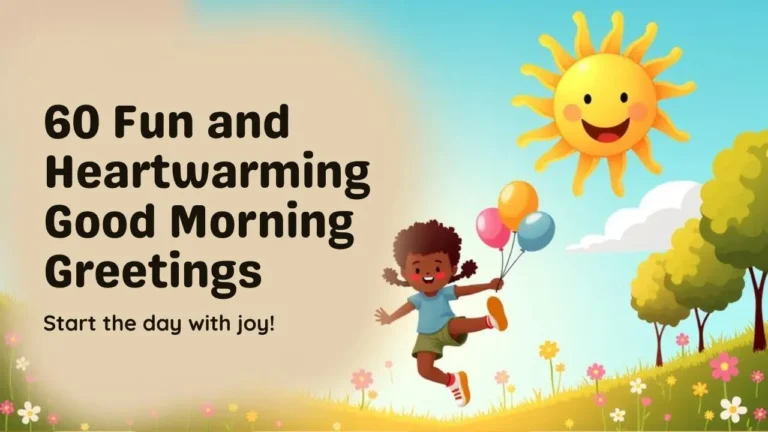A cheerful “good morning” can do more than start the day—it can lift moods, spark teamwork, and set a positive tone for the hours ahead. In busy workplaces filled with meetings, emails, and deadlines, kind words in the morning remind everyone that teamwork and respect still matter.
Good morning greetings for work are simple but powerful. They can make coworkers smile, help teams stay connected, and create a friendly environment where everyone feels valued. Whether the workplace is an office, a classroom, or a remote setup, a thoughtful greeting can brighten someone’s day and inspire better work.
Why Good Morning Greetings Matter at Work
Saying “good morning” is not just a polite habit—it’s a way to build stronger connections. When coworkers start the day with positive words, they often feel happier and more motivated.
Experts say that positive communication at the start of the day can boost creativity and reduce stress. It also helps people focus better on their goals. Even in online teams, morning messages help replace the friendly chats that happen in person.
A kind greeting can make someone feel noticed, appreciated, and ready to take on the day. It can also show professionalism and respect, which are important in every workplace.
Formal Good Morning Greetings for Work
Formal greetings sound polite and respectful. They are great for managers, clients, or professional meetings. Here are some examples:
Good morning! Wishing you success in every task you take on today.
Good morning, team. May your day be filled with focus and great results.
Good morning! Let’s start this day with clear goals and strong teamwork.
Wishing everyone a peaceful morning and a productive start to the day.
Good morning! May every meeting be meaningful and every plan come to life.
Good morning! Hope your day brings positive progress and bright ideas.
Good morning, colleagues. Let’s make today’s efforts count toward success.
Good morning! Hoping for smooth teamwork and steady achievements today.
Good morning, team. Let’s keep up the great work and make today count.
Wishing you a successful day ahead with new opportunities.
Good morning! Let’s take one more step toward reaching our goals.
Good morning! Every project begins with a positive start.
Wishing the team a focused and productive morning.
Good morning! May today bring growth and success in every way.
Good morning! Hope your schedule runs smoothly today.
Good morning! Let’s make this day full of learning and results.
Good morning, everyone. Let’s aim high and deliver our best.
Wishing you clarity, calm, and creativity this morning.
Good morning! Let’s build strong teamwork and stronger outcomes.
Good morning! May your ideas shine and goals move forward today.
Good morning, team. A positive start brings a successful finish.
Good morning! Ready to make today’s plans a reality.
Good morning! Let’s bring our best to every challenge today.
Good morning! Hoping for progress, peace, and productivity all day long.
Casual Good Morning Greetings for Colleagues
Casual greetings are friendly and relaxed. They are perfect for everyday chats among coworkers.
Morning, everyone! Let’s make today awesome.
Good morning! Hope your coffee hits just right today.
Morning team! New day, same great energy.
Hey, rise and shine! The day won’t start without us.
Good morning! Let’s tackle today, one smile at a time.
Morning vibes only—keep it positive and productive!
Good morning! Time to chase goals and refill coffee cups.
Morning! Let’s start strong and end stronger.
Hey team! Who’s ready to make magic happen today?
Good morning! A little laughter makes the workday fly by.
Morning! Let’s keep calm and coffee on.
Good morning, folks! It’s a brand-new chance to do great things.
Hey everyone! Let’s make this day shine brighter than our screens.
Morning, team! Another day to learn, laugh, and lead.
Morning sunshine! Let’s make the office buzz with good vibes.
Good morning! Hoping today’s to-do list feels shorter than usual.
Morning! Let’s keep smiles wide and spirits high.
Good morning, legends! Time to make today amazing.
Morning crew! Small steps lead to big wins—let’s go!
Good morning! Remember, every day starts with one good thought.
Morning! Let’s make this a day to remember for the right reasons.
Good morning! Work hard, laugh often, and stay kind.
Morning, friends! May your tasks be easy and your lunch be great.
Good morning! Time to make things happen—together!
Motivational Good Morning Greetings
Motivational messages help coworkers start the day with energy and hope.
Good morning! Every sunrise brings new chances to improve.
Good morning! Believe in progress, not perfection.
Good morning! Success begins with a positive attitude.
Rise and shine! Great days begin with great effort.
Good morning! Today’s small steps build tomorrow’s big wins.
Good morning! Stay focused, stay kind, and stay strong.
Good morning! Every challenge is a lesson in disguise.
Good morning! Confidence and effort always lead to success.
Good morning! Be the reason someone smiles today.
Good morning! A strong mindset brings amazing results.
Good morning! Turn today’s goals into tomorrow’s achievements.
Good morning! Don’t wait for inspiration—create it.
Good morning! The best view comes after the hardest climb.
Good morning! Dream big, start small, act now.
Good morning! Let positivity be your power today.
Good morning! Effort is the bridge between goals and success.
Good morning! Shine bright—your energy inspires others.
Good morning! Great things start with a single brave step.
Good morning! Keep learning, keep growing, keep going.
Good morning! Let today be proof of your dedication.
Good morning! Every effort today brings you closer to victory.
Good morning! The world is brighter because you’re part of it.
Good Morning Greetings for Remote Teams
In remote or hybrid offices, friendly morning messages help people stay connected even from far away.
Good morning, remote team! Distance can’t stop teamwork.
Morning from across the map! Let’s make today productive.
Good morning! No matter the miles, the mission stays the same.
Morning, everyone! Connected by goals, even if not by desks.
Good morning! Wherever you are, bring your best energy today.
Morning! Logging in with positivity and purpose.
Good morning, virtual crew! Let’s make teamwork our superpower.
Morning, team! Screens may separate us, but teamwork unites us.
Good morning! Let’s turn Wi-Fi signals into success stories.
Good morning! From one home office to another—let’s get things done.
Morning, remote friends! Let’s make collaboration easy and fun.
Good morning! A great day starts with great connection.
Morning, digital dreamers! Time to create something amazing.
Good morning! Let’s make the virtual workspace feel like home.
Good morning, team! Together, we can bridge any distance.
Morning all! Wishing you a productive day, no matter your time zone.
Good morning! Collaboration knows no borders.
Morning team! Let’s keep the energy flowing through the screen.
Good morning! Virtual teamwork, real results.
Good morning! Here’s to remote work done right—focused and friendly.
Fun Themed Good Morning Greetings
Adding a theme keeps messages fresh and fun throughout the week:
- Monday Motivation: “Good morning! A new week means new chances.”
- Wellness Wednesday: “Good morning! Don’t forget to take short breaks and stay hydrated.”
- Friday Fun: “Good morning! Let’s finish the week strong and happy.”
- Holiday Cheer: “Good morning and happy holidays! Let’s work with joy and gratitude.”
- Project Success: “Good morning! Congratulations on the great teamwork yesterday!”
Tips for Sending the Best Good Morning Greetings
- Send Early: Morning messages work best before 9 a.m.
- Keep Line Short: One or two or more sentences are enough.
- Stay Positive: Use cheerful and kind words.
- Be Genuine: Say what feels natural, not forced.
- Match the Mood: Use emojis in chat apps, not formal emails.
- Encourage Talk: Ask simple questions like, “How’s your morning going?”
- Be Consistent: Make greetings part of your daily routine.
- Show Care: Respond when others reply—it builds teamwork.
The Power of Positive Starts
A very simple “good morning greetings” can go a long way. It helps coworkers feel appreciated, supports teamwork, and builds a friendly atmosphere. Over time, these small words can make a big difference in how people work together and how they feel about their jobs.
When good mornings become a habit, workplaces become happier, more focused, and more productive. So, every day is a chance to start fresh—with kindness, encouragement, and positivity.
Conclusion
Good morning greetings for work may seem small, but they make a big impact. They spread positivity, bring teams closer, and make the workday brighter. With the right words, every morning can start with energy, motivation, and teamwork.
Simple acts of kindness—like a cheerful “good morning”—can turn ordinary workplaces into places of joy and success.
Frequently Asked Questions (FAQs)
1. What makes a good morning greeting effective?
A good greeting is short, kind, and fits the situation. It should sound natural and friendly.
2. How often should morning messages be shared at work?
They can be shared daily in small teams or a few times a week in larger ones.
3. Can emojis be used in professional greetings?
Yes, in chats or casual messages. But in emails, keep it simple and formal.
4. Why are funny morning messages helpful?
They help coworkers relax, smile, and build friendships at work.
5. How do greetings help remote teams?
They make remote workers feel included and connected, even from far away.








